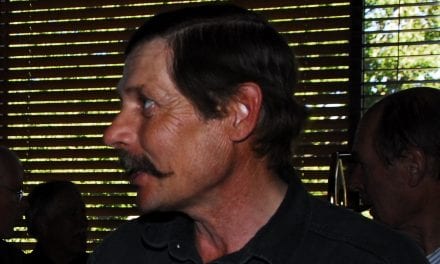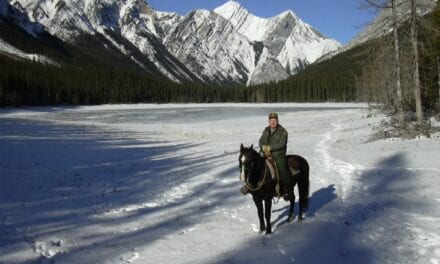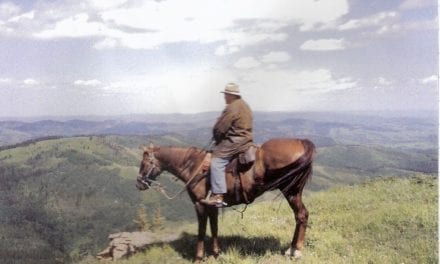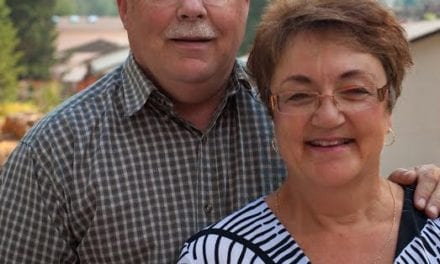Thank you to the Whyte Museum of the Canadian Rockies for granting permission to the Park Warden Service Alumni to post this interview on our website
Park Warden Alumni Society of Alberta
Oral History Project – Spring 2014
Telephone Interview with Bill Browne
Interviewed by Christine Crilley-Everts
April 16, 2014
Place and Date of Birth: Calgary, Alberta. February 24, 1947
Occupations: Bill began his career with the warden service in Kootenay National Park. From 1975 to 1981, he worked there are a seasonal warden before moving to Banff. After five wonderful years as a backcountry warden, he started working in the wildlife program. Bill then left Banff to work as the Assistant Chief Warden in Prince Albert/Waskesui National Park. From there he moved to the regional office in Winnipeg to serve as a Warden Service Officer. In 1995, Bill returned to the west to become the Chief Warden of Mount Revelstoke National Park where he worked until he retired from the service in 2005.
Additional Information: Bill remembers fondly the time he spent in the backcountry and working in the early years when national parks truly were for people.
Christine: “My first question is what is your place and date of birth?”
(0.37) Calgary, February 24, 1947.
“Did you grow up in Calgary?”
- I went to school in Calgary and I went to university in Calgary. I entered the pre-vet program with the intention of becoming a veterinarian. I made the mistake of joining a fraternity and found out that partying was easier than studying! I ended up with a three year degree that took me four years, a bachelor of science and no idea what I was going to do with it!
“How did you get involved with the warden service?”
- (1:38) Okay, I ended up working sidewalk construction in the summer and pretty well partying all winter and a friend of mine said, “Hey, we’ve got to get out of this rut.” He’d heard about this fish/wildlife management program out at BCIT (British Columbia Institute of Technology). He said, “Let’s go do that.” We were always kind of outdoors people, outdoors in the sense that we did a lot of hiking and camping out of Calgary. He applied for me because I hadn’t even got it together enough to apply and I got accepted, and he didn’t unfortunately. So I ended up with the fish and wildlife management diploma and the very first year I was offered a job by Fisheries and Oceans, which somebody told me to decline. I took a job with the Department of Mines, the BC Department of Mines, as a reclamation technician. During that year I had also gone to an interview with Parks Canada for a park warden position which I had no idea what that was. I thought they were the people that were up in the fire towers. Anyways I was offered a job at Yoho, but I already had that job with the Department of Mines and it was a good one and I declined it. Fortunately, the next year, Parks Canada phoned me again and said, “We have a job for you in Kootenay National Park. If you decline this one you will be removed off the list.” The Department of Mines, hadn’t offered me a job back yet, so I took it and that’s how I started.
“Would that have been in the mid 1960s?”
- No, I was later, that was 1975. Yes, I started off as a seasonal and I had a six month position that ran from June to December. Okay, I got laid off in December and the next year, I started and I went back to Kootenay again. I think it was June… I spent every year from then until 1981 (in Kootenay) and they were fortunate to keep me on fulltime, but I was still a seasonal position. I started again like you said in 1976 and I worked every year until 1981 when I finally got a fulltime job in Banff. I was in Banff from 1981 to about 1990.
- (5:46) In Banff I was a backcountry warden. I started out in Lake Louise, I had the Cyclone district. Then I was there for two years and I transferred into Banff. I had Egypt Lake for one year and then I was out in Red Deer Lakes, that area, and then Dormer, the east side there. I was the backcountry warden there for another almost five years. Then I worked with Rick Kunelius in the wildlife program. That was for two years, Rick took a leave of absence and I was in charge. The first year I worked with Rick, the second year Rick took, I believe a leave of absence or something. He left and I was in charge of the wildlife management program for one year in an acting capacity. You could smoke in the office back then! Rick and I were the only ones who were smoking in the whole building. We were way back in a corner!
- (8:08) During that period out of interest, that was when…a girl was dragged out of her tent at Tunnel Mountain, by a coyote… Your dad was majorly involved with that… (Keith Everts was a warden in Banff National Park from the early 1970s until 1995.) She wasn’t a small girl, like she was almost 14 or something, but the coyotes were very habituated to the Banff area and they would come into the Tunnel Mountain campground area at night. People in the townsite were feeding them and that. But anyway some girl had gotten dragged out of there so we decided that we would circle the campground with armed wardens and we were shooting any coyote in sight. That’s what we did for two nights and we shot six of them and we shot a few more in town after the fact. Things died down for a little while after that.
“Was she seriously injured?”
- Not really, but some good gashes eh. I think you will find that in the Calgary Herald (newspaper)…I know that she wasn’t a small child, she was 12 to14, something like that. I think she was with another girl. Her parents must have been in another tent. I don’t have that in my memory right now.
“So after your two years in wildlife, where did you go?”
- (10:20) Then I applied and got the Assistant Chief Park Warden job in Prince Albert National Park. I was there for two and a half years. It was a wonderful place to be in the summer, beautiful lakes, beautiful everything. Even the winters weren’t bad. The only problem with the winters was you lived in a little community with 60 people and they knew exactly how many sheets of toilet paper you used! And unfortunately during that period there was a strike on. My wife, after a week of the strike where she was out (on strike), she and some other colleagues decided they would go back in and it was not a good move. Of course I was a designated employee so I had to stay (working) strike or not, but my wife choose to break the strike and it was not a very popular move in that small of a community.
“So your wife Debbie worked for Parks as well?”
- She worked for Parks as well.) She started off in Kootenay as well, in a fire tower and then she was a conservation corp leader and then she worked in the office in finance in Prince Albert. In Kootenay she was also on the gate for a while. We met in Kootenay National Park. We have two girls. They are in BC right now. We have no grandchildren; I don’t know if that is a blessing or not!
“After your two years in Prince Albert, did you go to Revelstoke?”
- (12:56) No, actually…I was a GT4 in Prince Albert and my next step was I went to a GT6 in regional office in Winnipeg for the prairie and northern region. (It was different, having come from the field and knowing what regional and national headquarters really had to offer, you sort of wondered. Like you could be there to facilitate, but you kind of always shook your head (as to) whether you were really there to really assist the field or not. You were always busy, but you can be busy doing nothing too eh…I was in Winnipeg a little over two and a half years. Then I was in the position of warden service officer, much like Duane Martin was too…but with the cutbacks, then they cut that position, I think it was called redundant. I was on a priority list and that’s when the position for chief park warden of Revelstoke/Glacier opened up and I managed to win that position…and that is where I finished my career. I spent close to 10 years or a little over ten years there.
“Did you enjoy that after coming from the office?”
- (15:20) Okay, at that point in time, things were already starting to sour. Shelia Copps had taken over and Parks Canada was there to make money. And that was kind of a sour taste in everybody’s mouth. Then the issue of arming wardens came up and I am on the management side, I am supposed to support management and I am also trying to support the wardens. It was very awkward, very awkward for me…I retired on medical leave in 2004 and I used up my medical stuff and I officially retired in 2005.
“Are there any other wildlife stories that stick out in your memory?”
- (16:52) Well, the most famous one, if you‘ve talked to Johnny Nylund or Larry Gilmar or Rick Kunelius, you’ve probably already heard it, about the grizzly incident on the Panther Well, I’ll give you my side of it…I leave Windy Cabin, I wasn’t a real early ‘get awayer’, probably I left about 8:30 and this was in the fall. Johnny Nylund and Larry Gilmar were at the Dormer cabin coming the other way. I just get to the first creek crossing which is probably half a mile from the house, from the cabin and the horses stop for a drink. I am kind of half asleep and all of a sudden this huge grizzly comes flying out of the willows on the other side of the crossing and into the river. I have been bluff charged three or four times previous to that and they always come a little ways and then they veer off and take off. Anyway when this bear came, it went right into the river. The next thing I know, the horses shot their heads up, but the pack horse all of a sudden nearly tore me off the (saddle) horse and it was flying back…my saddle horse wheeled and the two horses were racing back to the cabin. The trail had been washed out, like it was really dangerous. It had been washed out in places, two or three feet. Anyway we raced our way almost back to the corral. I brought the two horses (to a halt) and thought, “What the heck? This is crap eh!” So I grabbed the pack horse and went back. I went back to the river, I went over a little bit up to a higher knoll and I yelled, “Hey you!” And damn it, if that bear didn’t come charging out! It chased us all back again. I unpacked the pack horse and I said, “I am going back just with the saddle horse.” Went back there and that bear is still there and I am not getting through. And I know that Johnny and Larry are coming this way. So I go back and get on the single side band and call the warden office and say “Hey, can you try and get ahold of Johnny and Larry and tell them that there is this bear at the crossing on the Panther and that they’ve got to be real careful.” Well, Rick was in the office and he heard it. So he says, “Hey, I’ll come out there.” He ended up getting in the helicopter, flying out there. Then we fly over…Johnny and Larry had already left. We land and tell Johnny and Larry that there is a grizzly and I am trying to count the number of crossings. Like you cross the Panther about six times. I am trying to count back from there, anyway I screw up. We told them, “Be careful at this crossing because there is a grizzly bear right there.” They keep coming, we fly back and Rick loads up the tranquilizer gun. We fly over there with this helicopter pilot, well, we don’t see any bear. I thought, “Well, god, maybe the bear has left.” The helicopter pilot is going, down, down, we are looking in these willows and all of a sudden a bear jumps up at the helicopter! You should have seen this pilot pull back on the stick! We gained about 30 feet in no time! So we know the bear is there and we move in. By the time they got out there we are looking at about two o clock or something and time is running out. Anyway, Rick loads the dart and shoots out of the helicopter. He saw the dart hit, but we didn’t see the bear go down. But what had happened was Rick did not bring any net or anything out with him, or the helicopter pilot didn’t have it in there. So he had to drop us off back at the Windy cabin and take off back to Banff and get the net so that we could load this bear out of there. Meanwhile, Larry and Johnny are still coming. We had left them a radio, so we had radio contact at that point. So they were coming…darn if they didn’t get there and they didn’t get my message very straight about which crossing it was at and the bear came after them eh. But it had taken some of the first dart. Here is the key thing, before that even happened and this went around the warden office for quite a while, they called to us and said, “Is that bear down?” And Rick had said, “Yes it is, trust me.” The “trust me” thing went around for quite a while! Anyway, this bear was not down and it came out after them. I guess Johnny said it was right after them. He had his own horse at that time and racing it down that riverbed actually hurt that horse. It was never the same after, but anyway, that’s what happened. Then the helicopter comes back, we fly back over the area and sure enough, the bear is still there as we knew it would be, but we did get another dart in it. It had been on an elk kill. We (landed) and put it and the elk in the cargo net and flew it up into a col just above the Panther River there. (A col is “a low point in a ridge of mountains, often forming a pass between two peaks.” Calvert, Kathy and Portman Dale. Guardians of the Peaks, Rocky Mountain Books 2006.) That’s my big story!
“Are there any rescue stories that stick out in your mind?”
- (25:54) I’ve been involved in a lot of the rescues, but I was never sort of the key player in them. Nothing that I can really think about…I was working in Rogers Pass when the seven students were killed in that slide that time. (In February 2003, seven students from Strathcona-Tweedsmuir School were killed in an avalanche while ski touring in Rogers Pass.) Again, I was the chief park warden there, so I was mainly organizing and stuff like that. That was a big one too. And the Sunshine slide where two people were killed in the trees there and being part of the party there. Nothing too spectacular because I mainly played a backup role.
“The student one must have been a hard one.”
- It was, totally
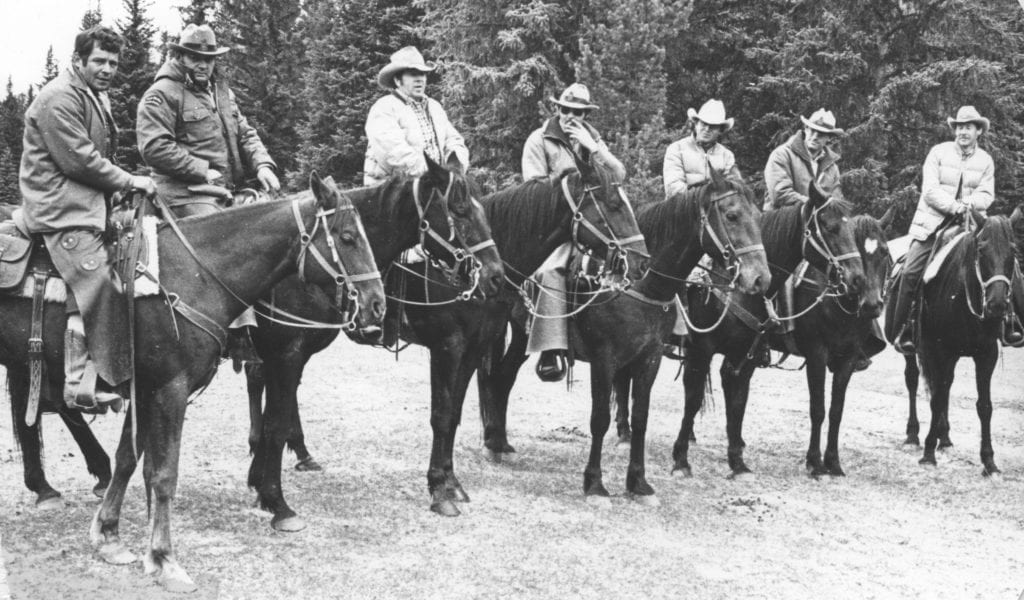
Trailing horses from the Ya Ha Tinda Ranch to Banff – 1985.
Gaby Fortin, Larry Gilmar, Johnny Nylund, Bill Browne, Jack Marr, John Taylor, Ian Pengelly.
Photo by Bruno Engler.
“What did you like best about being a warden?”
- (27:17) Oh the backcountry, a no brainer! The backcountry, and for the first 15 years when Parks were for people, they weren’t to make money (were the best parts of being a warden). It was a great environment for everybody that worked in it. It was super. At that time, you were law enforcement, public safety, public relations, you did everything. It was amazing!
“Just to go back a bit, you know your outdoor experience, was it with your family that you started going out into the mountains?”
- (28:10) I did and I was very fortunate that in the early years, management had no problem with you putting your kid on government horses and taking them into the backcountry and using government cabins. When I was a backcountry warden quite often I would take my family into the backcountry.
“It was the same thing with our family and I feel really lucky that we were able to do that.”…
- No kidding eh!
“Do your girls still like the outdoors?
- Oh, they love it! (You know, we skied into Stoney Creek and skied into Mystic Lake and they bitched all the time about how hard it was, but now they talk about how really wonderful it was. I remember taking my older daughter and six girls into Stoney Creek for her birthday. We cross-country skied in there and had her birthday party…It was spectacular! They remember that stuff…
“And you, as a kid did your parents take you out into the mountains?”
- No, they didn’t, maybe that is why I grew that way.) My dad, he never had any time for that. He did buy us a tent one time and we camped at Canmore in basically a relative’s yard. That was our camping experience. I think when I started university, we started backcountry trips and hiking and stuff like that. I fell in love with it, it was there. Just like I said, I wanted to be an animal person, a veterinarian, but the next thing I wanted to be was a conservation officer.
“And your horse skills, did you learn that on the job or did you have any experience with horses?”
- I had some advantage, I lived with an aunt and an uncle up in Marwayne, Alberta. They had an eight and a half section cattle ranch with lots of horses. I learned to ride up there. When I came and joined the warden service, I had the riding skills. I didn’t have the packing skills, Dale Loewen taught me that.
“Is there anything that you didn’t like about being a warden?”
- (31:46) Yeah, I didn’t like going into management, but I got greedy for the money. I didn’t like it when, like I said before, all of a sudden Parks were to make money. I didn’t like it when they decided that we were going to specialize, we were going to have public safety people and we were going to have law enforcement people. You know when you were a generalist it was much more fun, but I can understand too that it made more sense to be specialists as things got more technical that had to be the way it evolved.
“What are some of the more memorable events of your career?”
- (32:57) The Willi Pfisterer and the Peter Fuhrmann schools. There were two different characters there, like early rise and get at it; and Fuhrmann more laid back. But a lot of fun just the same. The Ya Ha Tinda Ranch, just going up there, taking the horses up there. That was something else too. The districts in a sense, even though I was sort of at the end of the district area, I did have districts. I had Marble Canyon all to my own and that was an experience and very memorable. (Marble Canyon is in Kootenay National Park. The cabin was next to Highway 93 South). All the things, like people (being) really stranded…there is one story I will relate to you there. We came home and there was a big note, “Please do not shoot. Our car broke down and we broke into your house. We are in your house right now.” Some people, I think they were from Texas, eh. Driving skidoos and rescuing people who were stranded when storms happened there. What else…Living by the Bow River, we lived down by the Recreation Grounds in Banff. My daughter Rayna would be about three or four years old and the Greeks would be fishing in that bay and they taught her how to fish. Going over to the outfitters camps when I was on boundary patrol, getting suppers and getting loaded. Then riding home and not even knowing where you were going, but the horse finally made it to the gate of the corral, those things!
“What about the warden service was important to you? Was it the idea of protecting and preserving the Parks?”
- (35:28) Absolutely! It was protection, but it was also making sure that people enjoyed the parks. I was going through these diaries and I couldn’t even remember it, but the amount of stuff that I had done in my early years like talking to school groups about backcountry travel, backcountry survival, and compass and map use, stuff like that. And getting people so they enjoyed the parks, and talking about the wildlife. It was great, and the wildlife studies we did, the water studies, the avalanche studies, the plant studies…It was always some kind of thing going on. There was always something going on, like the Vermillion burn when I was in Kootenay. Not that we ever knew where the data was going to be used, I don’t think it ever did get used! But we would pack up there with about 35 pounds of equipment on our back or on a horse. We would go up and do these readings and send them off to the University of Calgary, never knowing what really came of it, but we did it eh?
“You mentioned Willi Pfisterer and Peter Fuhrmann, are there any other characters that stick out in your mind?”
